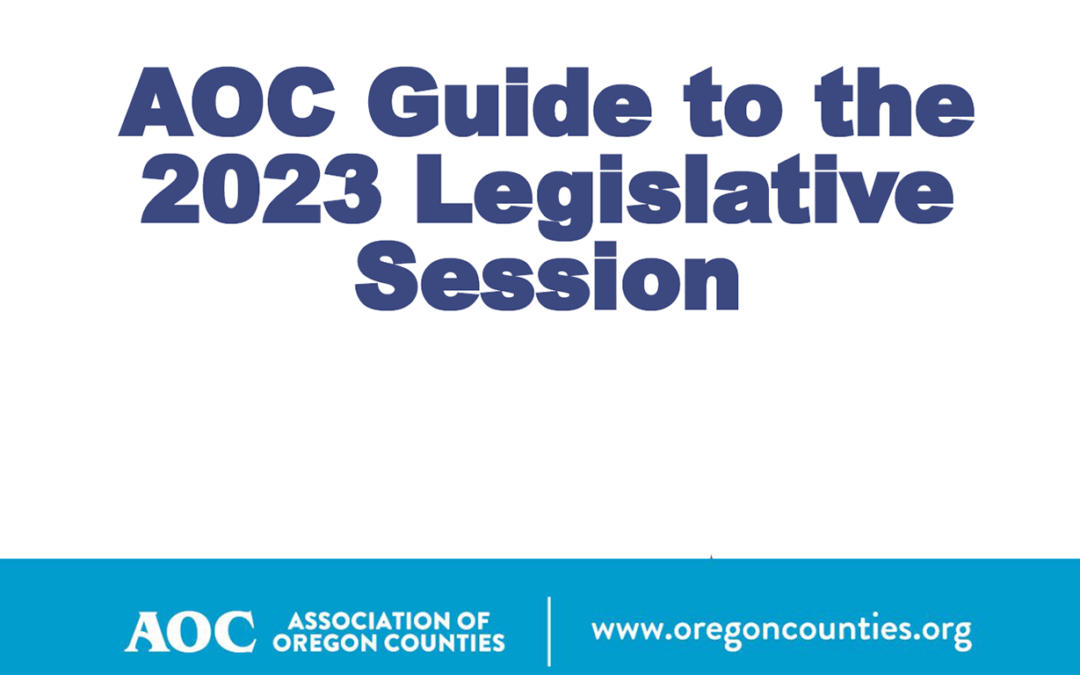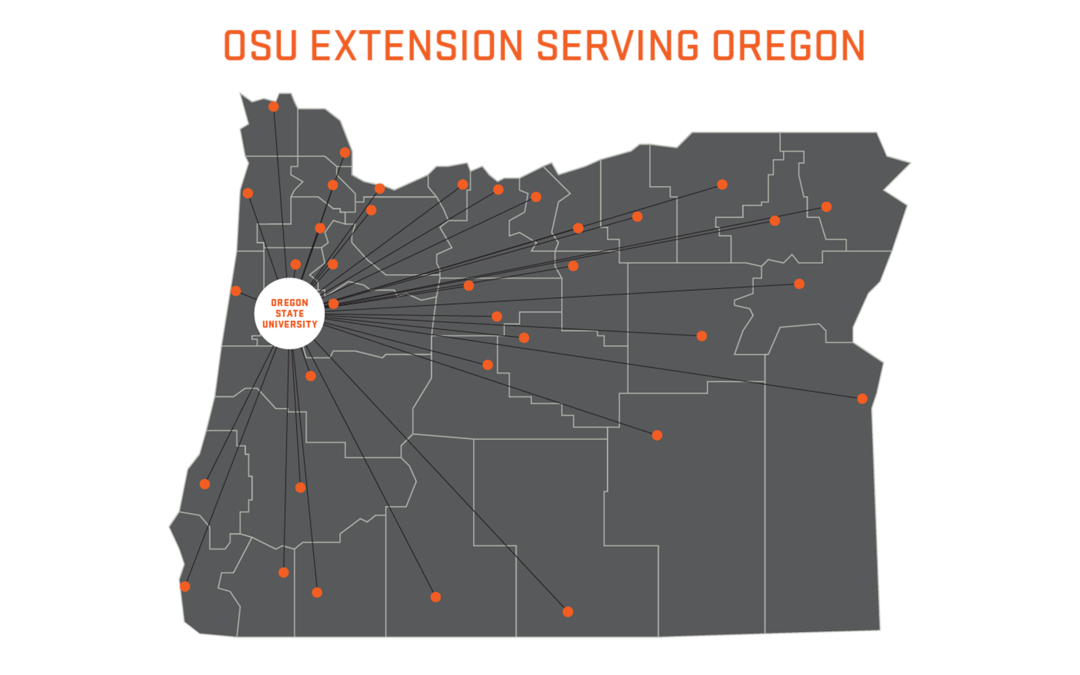
AOC Releases Guide to 2023 Legislative Session
|

|

The Association of Oregon Counties (AOC) is seeking the names of any members interested in representing AOC on the following committees:

On December 23, 2022, the U.S. Congress enacted a Fiscal Year (FY) 2023 omnibus appropriations bill to fund the federal government through September 30, 2023. Enactment of the omnibus followed a series of Continuing Resolutions (CR) to fund the federal government and avert a government shutdown since the beginning of the federal fiscal year on October 1, 2022. President Biden signed the $1.7 trillion omnibus appropriations bill into law on December 29, 2022.
For the second year in a row, discretionary spending levels for FY 2023 were not limited by statutory spending caps prescribed by the Budget Control Act of 2011. As such, the White House, congressional leadership, and top appropriators negotiated topline spending levels over several months.
The FY 2023 omnibus includes several key investments of importance to counties detailed in this report. These include, but are not limited to, full funding for the Payments in Lieu of Taxes (PILT) program and significantly invests in the RECOMPETE pilot program and technology hubs authorized by the bipartisan CHIPS and Science Act. These programs and others funded by the bill, including a $550 million increase in wildland fire suppression, will enable counties to provide critical services and plan for economic sustainability and growth in 2023.
The final omnibus represents a total of $1.7 trillion in discretionary spending across all 12 spending bills. Of this total amount, $773 billion is in non-defense discretionary spending, an increase of 5.9 percent over the comparable FY 2022 level, and $858 billion is in defense discretionary spending, an increase of 9.7 percent.
In addition to regular programmatic funding and extensions, the FY 2023 omnibus included nearly $10 billion in earmarks (rebranded as community project funding and congressionally directed spending), representing 4,000 projects, for the first time in nearly a decade, although with increased transparency and guardrails. As a result, hundreds of county programs and critical infrastructure projects aimed to better serve communities will receive direct federal investments.
The omnibus bill delivers on many county priorities which are detailed in the National Association of Counties (NACo) report here. Notably, during consideration of the final omnibus agreement, the U.S. Senate adopted an amendment to the package offered by Sens. John Cornyn (R-Texas) and Alex Padilla (D-Calif.) the bipartisan State, Local, Tribal and Territorial Fiscal Recovery, Infrastructure and Disaster Relief Flexibility Act. This amendment grants additional flexibility to county governments in investing resources from the American Rescue Plan’s (ARPA) Coronavirus State and Local Fiscal Recovery Fund, including infrastructure, community development, and disaster response. It will also provide the U.S. Department of the Treasury with much-needed resources to assist counties in deploying recovery funds.
This analysis includes funding highlights for key programs impacting counties. Click here to view NACo’s analysis.
Click here for the original article.
Contributed by: The National Association of Counties

The Oregon State University (OSU) Extension Service partners with local communities, providing trusted expertise and science-based knowledge to respond to local needs, challenges, and opportunities.
Our work is as richly diverse as Oregon’s communities. We’re helping kids reach their full potential and expanding educational access through 4-H and other youth programs. We’re encouraging resilience across the food chain — from pollinator health to farm and ranch productivity. We’re supporting sustainable natural resource management and enhancing health and well-being for every stage of life.
Our mission, put simply, is to help every Oregonian thrive. Our relationship with Oregon counties is crucial to fulfilling that mission.
A strong partnership
OSU Extension has a presence in every Oregon county and the Confederated Tribes of Warm Springs.
Local governments provide important financial and advisory support, ensuring that our work is directed toward community priorities.
Twenty-six counties support Extension with voter-approved service districts or levies; nine others provide general fund allocations. Every $1 invested by counties in OSU Extension leverages $2 in state funding as well as federal, grant, and philanthropic funding. These county dollars directly support county needs, including facilities and local program support.
In January 2023, we were honored to again partner with the Association of Oregon Counties to offer County College. This biennial program provides a comprehensive overview for new commissioners, judges, chairs and high-level staff and opportunities to explore the strong partnership between counties and OSU Extension.
A look ahead
OSU Extension is one of three statewide OSU public service programs, along with the Oregon Agricultural Experiment Station and the Forest Research Laboratory. These programs, known as the OSU Statewides, receive a state funding allocation separate from the university’s general budget.
Guided by stakeholder input, in the 2023-25 biennium the OSU Statewides will seek $206 million in state legislative funding, which is a $50 million increase. This investment supports:
While Extension efforts are included in all aspects of the request, they are the centerpiece of the community resilience focus and will directly benefit rural and urban communities by:
State funding is a critical complement to investment by counties in OSU Extension, and provides for delivery of statewide programming that is responsive to local needs.
We value, and depend on, the support and collaboration we receive from Oregon’s counties. And we look forward to what we will continue to accomplish together.
We invite you to learn more about how OSU Extension is serving Oregon: extension.oregonstate.edu/impact
Contributed by: Dr. Ivory W. Lyles | Vice Provost, Division of Extension and Engagement, Director, OSU Extension Service
*AOC Partner sponsored article.

In 1960, a group of six counties in Oregon saw the need to bring great health insurance coverage to their members. These leaders knew the advantage of pooling their dollars together to help keep costs down and purchase the best benefits for their members. In turn, the Association of Oregon Counties (AOC) formed the Association of Oregon Counties Insurance Trust (AOCIT).
Rooted in the same cause as the AOC, Regence has had the honor to provide great health insurance benefits to AOC members for more than four decades through our partnership with CIS Benefits.
Regence is committed to driving a simpler, personalized, and more affordable health care experience for the people and their families we serve. Our partnership with CIS Benefits allows us to offer an expansive network across Oregon to its members and help keep costs down. CIS Benefits allows AOC members to bundle their benefits together, achieve lower rates and save counties and their workers money on their health benefits. Since 2019, the average annual rate increases for CIS Benefits self-insured medical program for counties administered by Regence has been 3.33 percent for pooled groups with fewer than 100 employees.
This community-oriented approach to health care is a fundamental part of our health insurance. Regence was formed in a very similar way as the AOCIT a little more than 40 years earlier. A group of loggers wanted to find a way to pool resources together to help their fellow loggers. They knew even a minor injury could bankrupt a family. This group decided to form a community fund, this way medical costs could be shared by everyone. It was people helping people. A mission that hasn’t changed for Regence in our more than one-hundred-year history.
Regence is honored to continue our partnership with CIS Benefits and offer simple and affordable healthcare benefits to AOC members. Those Oregon counties looking to learn more about CIS Benefits administered by Regence can reach out to the CIS team at employeebenefits@cisoregon.org.
Contributed by: Angela Dowling | president, Regence BlueCross BlueShield of Oregon
*AOC Partner sponsored article.